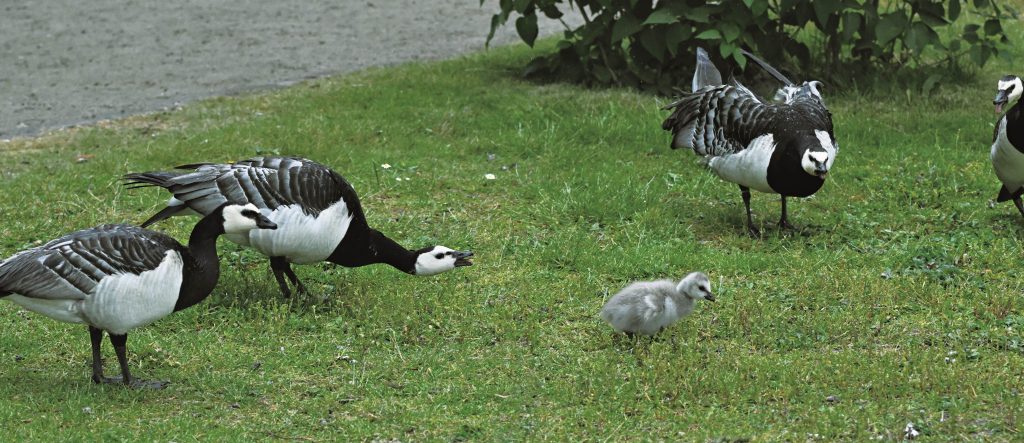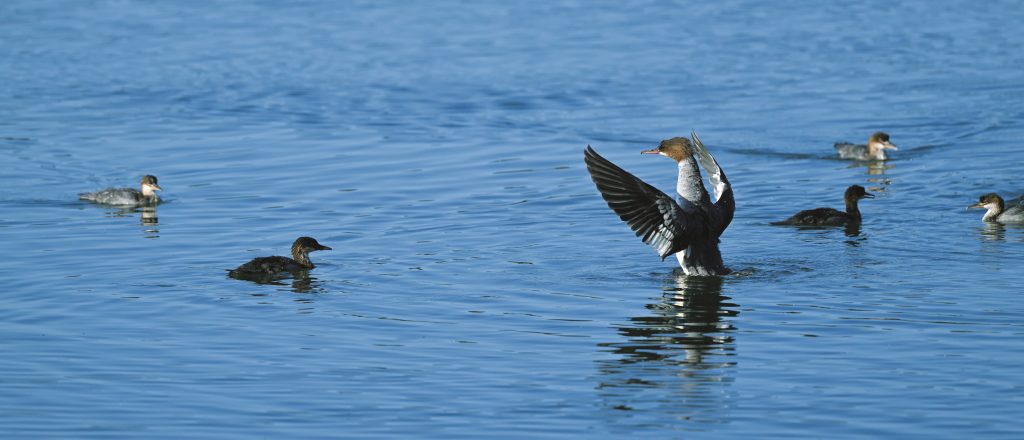Summer in Northern Europe – Family Ties

“Through the Lens” Fujingahou Magazine, June, 2024
Photos and text by HIH Princess Takamado
Photo edited by Koichi Fujiwara(NATURE’S PLANET)
Edited by Yuki Masuda (Fujingahou)
Five years ago, when Japan and Finland celebrated the 100th anniversary of diplomatic relations, a photo exhibition of birds I took was held at the National Archives in Helsinki as part of a commemorative event. After the exhibition, it was decided that these photos would be displayed permanently at the Mikkeli branch of the Archives. Last June, I visited Finland to attend a commemorative ceremony. I luckily also had time to take pictures, so this time I’ll introduce pictures I took at that time of waterfowls parenting.
The first picture is Barnacle Goose. There were several geese in front of the museum of the Fortress of Suomenlinna and I noticed two pairs with a small chick. The left parent bird, who later joined, stretched out its neck and lowered its head, and at almost the same time the right parent bird did the same. I think they were lightly checking each other out since they both had chicks, but it was a heartwarming scene as if they were exchanging greetings.

64cm Anatidae
It breeds from Greenland to the Norwegian Svalbard Islands, and islands in the Baltic Sea as well, and winters in eastern North America, UK, and other Northern Sea coastal countries.
When breeding on a bluff, hatched chicks fly down from the nest, leaving it, yet really, unable to fly at all.
The next picture shows the mother and child of Mute Swan. This time, I was able to observe the behaviour of the two parent birds and the chicks, since it was taken from a slightly higher position by the lake. The chicks swam in shallow waters near the shore, and the mother swam along the lake to protect them while guiding them. The male swan followed closely from a distance with caution, and when they arrived at an area with a lot of vegetation for feeding, he joined the family and they all foraged together.
In Andersen’s fairy tale “The Ugly Duckling”, the ugly duckling was bullied for being grayish compared to yellow duck chicks, and the chick who grieved over his ugly appearance grew up to be a beautiful swan. Seeing these swans and chicks, I fondly remembered that when my children were still young, after reading the story to them, I used to tell them, “This gray is the colour for the chick to protect itself.“


152cm Anatidae
It breeds from Europe (except Spain) to Kazakhstan and Inner Mongolia in China. Those migrating in winter season winter in southern Iran and the Bohai coast.
In Japan, some birds kept as pets have become wild, and in some areas, such as Teganuma, Chiba Prefecture, as many as 200 birds breed.
Its Japanese common name, ‘Hump Swan’, comes from the appearance of the bottom part of the upper beak which has the hump.
There were pebbles of various sizes near the shore and the chicks swim among them. They were moving their legs under the surface of water, but when viewed from above, there was not much movement. Especially with their heads in the water, they looked like pebbles. I was amazed at their ability to camouflage themselves so well that even through a telephoto lens I could not spot them clearly…
Finally, here is a picture of a family of Common Merganser (Goosander). The male’s head during the breeding season is glossy greenish black, while the female’s head is brownish red. The average number of eggs laid is 7 to 13 or even more in some cases. I was told that the chicks in the photo are about 6 weeks after hatching. Goosanders do not bring food to the nest. The chicks follow the parents as they practice feeding themselves shortly after hatching. The parent birds carry the small chicks on their backs so that they do not lose body heat and cover them with their wings to protect them from predators, including large fish. I couldn’t help but empathize, thinking that this mother bird must feel much more at ease now after raising ten chicks to this point.
In Finland, the summer holidays begin the weekend around the summer solstice when grandparents, siblings, children, and grandchildren gather in suburban homes to enjoy the midnight sun in a harmonious and lively atmosphere. When I visited, I was also impressed by the traffic jam of cars leaving Helsinki on Friday night, but in contrast, the following day was surprisingly quiet.

65cm Anatidae
It breeds in Eurasia and central North America, and winters in the south.
In Japan, they come to the north of Kyushu as winter birds, and in Hokkaido, a small number of them breed. It is found in freshwater areas and coastal areas such as rivers and lakes.
To make it easier to catch fish, the beak is long and slender, with fine jagged projections up and down, and a hook at the end.
It was fun to get together, but after everyone left, I felt so tired, but my friends with their cheerful smiles looked so happy. Finnish families people gather in large groups. I felt the parallels with birds working hard to take care of their chicks. It was a refreshing trip to Northern Europe that made me think again about family ties and child-rearing.